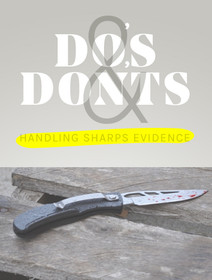Posted by QC on 25th Mar 2019
Stay Sharp Collecting Sharps
THE DO'S AND DON'TS OF COLLECTING AND PACKAGING SHARPS
Frequently, drug cases also contain various puncture, scratch, and cut hazards from objects such as syringes, razor blades, and broken glass. These types of hazards need to be packaged in a way that protects all the individuals who handle that specific piece of evidence.All syringe and sharp hazards should be packaged separately from other evidence. Syringes should be packaged individually in hard plastic tubes, boxes, or syringe safes. Sharps and glass should be packaged in hard-sided containers to protect from puncture and/or breakage. Glass that is already broken should be treated as a sharp hazard and packaged as such. As always, each agency has their own SOPs which should be followed. These are general directions we have found across multiple procedure manuals.
DO:
- Use extreme care when dealing with syringes. If possible wear protective gloves and face gear.
- If item contains wet blood or body fluids, air dry in a drying locker before pack-aging.
- If recovered in water keep submersed in the same water and package in water filled container. A sheathe may be packaged with a knife unless evidentiary value will be damaged.
- Pieces of broken glass must be packaged in a box. Avoid packaging several pieces of glass in one container to protect potential evidence.
- Always plainly mark the storage box with the word SHARPS or affix a SHARPS sticker.
- Sharps, such as knives and glass, must be submitted in a hard-sided container. The container should protect those handling the evidence and prevent the breakage of fragile evidence.
DON'T:
- DO NOT attempt to recap syringe.
- DO NOT use the styrofoam if the item is considered biological evidence.
- DO NOT air dry items found in water. Keep in original water.
- DO NOT submit syringes for drug analysis which do not contain visible liquid or residue. Syringes should be packaged separately and be submitted in a hard-sided container, such as a sealable plastic tube.
- DO NOT wrap evidence tape around syringes or sharps.
- DO NOT wrap syringes in plastic bags, cloths, etc., before placing in approved sharps containers.
- DO NOT package sharps in a paper or plastic bag.
- DO NOT submit syringes or sharps if they are not essential to the case.
SOLUTIONS:

Sharps Evidence Collection Tubes
These clear plastic tubes will preserve the evidence and protect the evidence custodian. Both sizes include a custom foam insert for immobilization, evidence strips for sealing, and a biohazard label to clearly mark the evidence as a possible hazard.
Adjustable Evidence Tubes
These PVC adjustable tubes will extend up to 24" in length, safely storing evidence of varying lengths securely in place. These reusable tubes are rigid, durable, and resistant to humidity.
Evidence Collection Tubes
These clear plastic tubes will preserve the evidence and protect the evidence custodian. All three sizes include a custom foam insert for immobilization, evidence strips for sealing, and a biohazard label to clearly mark the evidence as a possible hazard.

Quikstor Knife Sheath
This QuikStor Knife Sheath provides a quick solution to cutting and folding cardboard to fit knives. These ready to use sheaths come in 2 different sizes and can be cut to length as needed. Just squeeze, insert knife, seal with SealGuard Evidence Tape and store. These sheaths are a packaging solution for all sizes of knives. The QuickStor Knife Sheath is a durable solution to alleviate large sized tubes/boxes for transportation.
Sureseal™ Sharps Label
The SealGuard™ Biohazard warning labels contain the international Biohazard Symbol and are printed on fluorescent orange stock to insure visibility and are provided on a roll for easy dispensing. Contains Sharps Biohazard Label. 3” x 2” 250/roll


